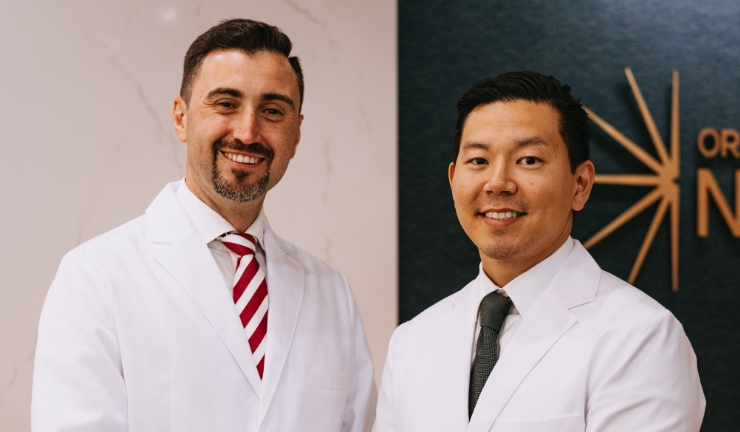These instructions apply for surgical treatments that include both tooth extraction and the placement of grafting material in the extraction site. Often, the grafting material is included with the tooth extraction to prepare the socket for possible placement of the dental implant.
The bone graft consists of many small particles and components. It is placed carefully within the socket to keep the graft in place. But the wound can be easily disturbed, causing graft particles to come out. Don’t be alarmed if you notice the loss of graft particles. At the same time, you should be proactive in preventing the loss of graft particles by following these tips:
- Do not touch or disturb the wound.
- Minimize spitting or rinsing for the first 24 hours, to allow the blood clot and graft material to stabilize.
- Do not push your tongue or fingers on the grafted area. The material is movable during the first few days of healing.
- When a front tooth is removed, don’t pull or lift up on the lip to see the sutures. This motion can damage the wound site and potentially tear the sutures.
- Do not smoke.
Twenty-four hours after the surgery, the mouth can be cleaned using a gentle salt water rinse. Be careful to avoid vigorous rinsing because the bone graft granules can still be disturbed.
If a temporary tooth was placed, it can be removed as instructed by the doctor. This temporary tooth can be worn as long as there is no irritation to the gum tissue. Please contact the doctor for an adjustment if any gum irritation is occurring.
These post-operative instructions are provided to help you experience a smooth, pleasant recovery. Read the information carefully and follow the recommendations. You are welcome to call our office any time if you have questions or need assistance.
Early Care After Surgery
On the day of the surgery, patients have optimal results when following this sequence:
- Control Bleeding First: The patient should stay in a sitting position and bite on gauze until the bleeding stops. Do not spit. Apply ice packs to the affected areas immediately.
- Eat Something: Getting something in the stomach is important. A milkshake is suggested.
- Start Medications: If the patient is experiencing pain, then the pain medication should be taken first, followed by the antibiotic an hour later. If the patient is not experiencing pain, then the antibiotic should be taken first, with the use of pain medication when the pain is starting to occur.
Bleeding
Apply moistened sterile gauze (a thumb-size roll) or a teabag over the wound. Bite hard with constant pressure for an hour, using 80% of your maximum bite force. The bulk of the gauze should be placed over the socket directly, so it acts as a barrier to minimize the amount of blood that is exiting the socket.
If the mouth is filling up with blood, then it means that the gauze is not sealing off the area. The gauze should be adjusted to achieve a better seal. Another cause for blood filling the mouth is if intermittent pressure is applied on the gauze or the patient starts talking, causing the gauze to move out of position.
Even when the above techniques are used properly, it may take as long as 3 to 4 hours for the bleeding to stop.
Ignore bloodstain on the gauze as a sign of bleeding. Ideally, someone other than the patient should check for bleeding and help with the gauze application. At the end of each hour, the gauze should be removed and the wound needs to be checked for further bleeding. Look at the wound directly for 20–30 seconds, using a flashlight and spoon handle (as a retractor) if needed. Don’t be surprised if the patient can’t open wide. A partial opening should be sufficient for you to see if it is bleeding.
If you see “jelly clots” (blood clots) on adjacent teeth, then they should be wiped off. This might stimulate some bleeding but is the correct care for the wound. These clots form when the gauze does not seal off the gum opening. Blood seeps outside of the socket and clots on nearby teeth and tissues.
If you see blood coming from the socket directly, then a new pressure gauze should be placed to seal off the area. The patient should be instructed to bite constantly for another hour. It is important for the patient to keep their mouth closed during this time. Check the socket again after an hour has passed and repeat as necessary.
Variable bleeding is expected after oral surgery. It is not uncommon to experience oozing, slight bleeding, or redness in the saliva. Wiping or rinsing any old clots from the mouth can help with the control of excessive bleeding. If the wiping creates more bleeding, then the mouth can be rinsed one time using a mixture of 50% hydrogen peroxide and 50% water. The mouth will foam, then it can be rinsed one time using cool water. No further rinsing is suggested. Next, place a new gauze pad over the area for one hour, then check the socket for bleeding again.
If the bleeding continues after following these instructions, then bite on a moistened tea bag for 30 minutes. Tea bags contain tannic acid that helps with clot formation by contracting bleeding vessels. Further bleeding can be minimized by sleeping with the head elevated and avoiding exercise or strenuous activity.
If the bleeding does not stop, then call our office for further instructions. In the first 24 hours, it is normal to have minimal bleeding and red or pink saliva. Also, bleeding can occasionally recur through the week after surgery. Usually, the bleeding will stop by itself, but pressure gauze can be applied if the bleeding is persistent.
Consider placing a towel to cover your pillow the night of the surgery. Minor oozing and drooling might occur while sleeping.
If your oral surgery was not an extraction of a tooth, then you should follow the bleeding control instructions provided by our staff. We always provide detailed information specific to the procedure that was performed.
Pain
The first 12–24 hours are usually when the most discomfort is experienced. Severe pain can be treated using the prescribed medications, taken as directed. Moderate pain can be treated using ibuprofen (Advil or Motrin: 200mg tablets, taken every 3–4 hours). Tylenol can be used as well, following the dosage recommendations as listed on the package.
Keep in mind that most pain medications can cause an upset stomach. The risk of stomach discomfort is highest when medication is taken on an empty stomach and prescription pain medication is used. If general anesthesia was used and the stomach is empty, then it is recommended to drink a milkshake followed by the first dose of medication 30 minutes later. A more effective option is to eat something soft and bulky (mashed potatoes, oatmeal, ground meat, etc.) 30 minutes before the medication.
Important Medication Reminders
CAUTION: Patients should not drive or operate mechanical equipment when using prescription pain medication. Also, alcohol should not be mixed with any type of pain medication (over-the-counter or prescription). Do not mix alcohol with antibiotics.
- Different medications should be spaced at least an hour apart from each other
- Eat food with some thickness 30 minutes before taking medication
- Always follow the dosage and frequency prescribed on each bottle
- Pain medications are beneficial to take the edge off of strong pain, but they do not eliminate all pain
- Avoid alcohol when using pain medication and/or antibiotics
- If taking narcotic medications, you should not work or drive a vehicle
Postoperative pain varies between patients. The worst pain is usually experienced in the first 72 hours, but some people experience a worsening of pain after the first few days. The overall trend is that pain should taper off within 5–6 days, although it is common to experience pain variations from one day to the next.
Exercise, strenuous activities, or following a “busy” lifestyle tends to cause a throbbing sensation in the wound. Use common sense and minimize activities if you find the pain or discomfort intensifies.
Antibiotics
If you have been prescribed antibiotics, then the first dosage should be taken 1 hour after taking pain medication. Continue using this medication as prescribed until the entire prescription has been finished.
Be aware that antibiotics might decrease the effectiveness of other medications, such as birth control pills. Talk to your obstetrician to know how long alternative birth control methods should be used after stopping the antibiotic.
Swelling
Drs. Blecha and Jandali use precise surgical techniques to minimize and prevent swelling whenever possible. But the swelling that occurs will be proportional to the procedure. It is common for patients to experience swelling around the cheeks, mouth, eyes, and sides of the face. This reaction is expected and a normal part of the healing process. Usually, the swelling peaks within 72 hours, then will take 5–6 days to subside.
Ice packs can be used for swelling reduction. If you don’t have ice packs, homemade packs can be created using a Ziploc bag filled with ice. All ice packs should be wrapped in a dry washcloth or hand towel before applying the pack on the sides of the face.
Ice can be used in 30-minute intervals: 30 minutes on, 30 minutes off. Start the ice pack treatment on the day of the surgery and continue as needed – up to 72 hours after the surgery. After 72 hours, you can bring the swelling down by placing moist, warm, heat applications on the sides of the face.
Smoking
It is recommended that patients shouldn’t smoke for the first 48 hours after surgery. Preferably, patients should wait for a week after surgery before smoking again.
Diet
Reestablishing your diet after oral surgery is beneficial to promote healing. Chewing might be difficult in the first 5–6 days if your jaw is stiff and difficult to open.
When the bleeding stops, we recommend a milkshake. Next, patients can move on to soft, bulky foods, such as oatmeal, mashed potatoes, and ground meat. These ingredients are important in preventing vomiting and nausea from the use of medications.
Ask a family member to chop up the foods into small enough pieces so you can eat them with a spoon and swallow without chewing. Drink 5–6 glasses of liquid per day to supplement the bulky foods.
Even if your jaw is stiff and sore, you must be consistent with eating bulky foods so your stomach can tolerate your medications.
Nausea and Vomiting
The risk of postoperative nausea and vomiting is highest when the patient isn’t eating well and is taking postoperative medications. Pain medications are commonly the cause of stomach upset.
If nausea and/or vomiting is experienced after the surgery, then don’t eat or take anything by mouth for an hour (including prescribed medications). Slowly sip on a Sprite or Coke for 15 minutes.
When the nausea subsides, try to eat bulky foods (as listed above). If these foods are tolerated, then you can try to resume the use of medications once again. Usually, the narcotic pain medication is the cause of nausea. If these prescriptions are needed for pain management, be slow in resuming the use of the prescription and try taking a lower dose to minimize nausea.
Oral Hygiene
Do not rinse or brush your teeth for 24 hours after surgery. After 24 hours, clean the mouth by brushing and following the salt-water rinses as directed below. Keep in mind that good hygiene after surgery is essential to help your mouth heal faster and to reduce the pain as quickly as possible. If you are too “shy” to brush and rinse, then it increases the likelihood of the development of a postoperative wound infection and pain that worsens.
Twenty-four hours after tooth extraction, all of the teeth should be brushed (including the teeth adjacent to the surgical site). Don’t scrub too hard. Instead, carefully clean the surface of all teeth, including “nooks and crannies” where food can get stuck.
At this time, you should also start using salt-water rinses. Mix 1/2 teaspoon salt in a glass of warm water, then gently “swish” to remove food that gets stuck in the surgical wounds. You should brush and rinse – saltwater swishing does not replace brushing.
If you find it difficult to open your stiff jaw 4–5 days after surgery, then stretching exercises can be used so you can open your mouth wider. Not only will opening your mouth wider make it easier to clean your teeth, but it also improves your ability to eat.
REMEMBER: A clean wound heals better and faster.
Activity
Immediately following surgery, physical activities should be kept to a minimum. Avoid exercise for 5–6 days. Strenuous activities can result in throbbing or bleeding. If these problems occur, then you should discontinue the activity.
During this recovery time, your normal caloric intake may be reduced because it is difficult to eat. As a result, exercise may weaken you. If you are feeling light-headed, then stop exercising. Be careful to ease your way back into an exercise routine to avoid complications for your recovery.
Discoloration
Some patients experience skin discoloration after surgery. When the blood spreads beneath the tissues, it can cause the development of green, blue, black, or yellow discoloration. This postoperative discoloration is normal, and usually shows up 2 or 3 days after surgery. Moist heat can be applied to the area to speed up the healing and fade the discoloration.
Sore Throat & Corners of the Mouth
The IV anesthesia or extractions can cause the development of a sore throat. The throat muscles are near the surgical site, and it can cause pain when these muscles swell. This pain is normal and should subside in 2–3 days. Saltwater gargling can help to reduce the pain.
During the surgery, the corners of the mouth can be stretched – causing them to crack and dry out. This discomfort can be managed by applying lip balm or an ointment (such as Vaseline) to keep the corners of the mouth moist.



